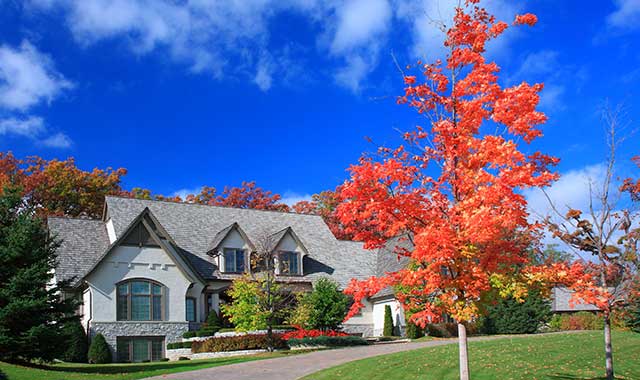In many ways, fall gardening can set you up for a beautiful landscape now and in the future. Local experts share tips to help your landscaping project survive the winter and flourish in the spring.

When we think of fall, our thoughts may turn toward football, apple orchards and time spent with family in the cooler weather. But for many gardeners, it’s easy to take for granted the importance of autumn landscaping.
Spring and summer are the most natural seasons for gardening, but getting dirty in the fall can, in many ways, set you up for a beautiful spring landscape. If planted correctly, most trees, shrubs and perennials will survive the winter months. And for plenty of perennial bloomers, now is an optimal time to show them off while helping them to establish roots.
Experts in our area share some tips to help your landscaping project survive the winter and flourish in any season.

Mum is the Word
They are a staple in many autumn landscapes, and they come in all variety of colors. When cared for properly, garden mums can be an asset long beyond the fall season.
“Mums are something you can plant now for blooms in the fall, and with proper care, they will winter over and come back to bloom again in the spring,” says Lori Harms, Greenhouse Manager at Countryside Flower Shop, Nursery & Garden Center in Crystal Lake. “So, if you plant them now, you can get two seasons out of them each year.”
Mums come in plenty of bright colors including yellow, white, red, lavender, purple, orange and bronze.
It’s best to get them into the ground sooner than later so they have time to set roots before winter. A well-rooted plant is more likely to survive the winter.
“If you wait until the end of October to plant them, we could get cold weather three weeks later and the ground will freeze, so they won’t be able to survive the winter,” Harms says. “They need six weeks of rooting in the ground to be able to survive the cold.”
Once you plant your mums, cover them with a layer of mulch, which adds insulation for the plant’s root system now and through the winter. Harms suggests adding about two inches of mulch on top of the soil, being sure to rake it smooth while keeping it away from the stem of the plant.
“You want to put the mulch around the outside edge of the plant and not up to the stem itself, because the mulch decomposes while it’s on your soil,” Harms explains. “While that is happening, it gives off heat, which can damage the plant stems, especially ones that are sensitive.”
Harms says the people with the most success overwintering their mums avoid the temptation to cut back the leaves and stems after the flowers have died.
“The plant will continue to root into the ground as long the leaves are left on the plant,” Harms says.
Keep an eye on the weather through September and October. You’ll want to have mums set in the ground and mulched over before the first frost – which typically falls between Sept. 15 and Oct. 15, depending on the full moon. Frost occurs when the overnight temperature falls between 30 and 35 degrees; it usually appears between 4 a.m. and 6 a.m.
“If we don’t have a frost at the full moon in September, chances are we won’t have a frost until the full moon in October,” Harms says. “We also watch for the full moon in the spring to know when we can start putting out our annuals. You don’t want to put them out before the frost, or it will kill them.”
It’s possible to extend the life of your plants when you protect them from frost. The night before, cover your mums and other delicate plants with an old blanket, sheet or cloth.
“Avoid the use of plastic coverings, which is a common mistake,” Harms says. “The plastic will draw the frost right through it and onto the plant itself. If you were to take a sheet or a blanket, the cloth will absorb the moisture and it won’t let the frost hit the actual leaves of the plant.”
Plants in containers can be placed underneath your home’s awning or stored overnight in the garage.

Taking Care of Your Trees
Just because the temperatures are getting cooler doesn’t mean you can’t plant a new tree.
In fact, Matt Zerby, president of Wasco Nursery and Garden Center in St. Charles, plants trees until the ground freezes.
“We’re generally planting trees until about Dec. 5 or 10,” he says. “For the most part, trees are approaching dormancy right now, so their systems are shutting down. It’s a lot easier to plant in the fall than in the spring when the plant is waking up and trying to grow.”
If it’s abundant fall color you’re looking for, Zerby suggests planting a maple tree because it offers good shade all summer while providing bright colors in autumn. He also recommends the autumn brilliance serviceberry tree, a smaller ornamental tree that’s perfect for this time of year.
“It has beautiful fall color and a nice, white spring flower,” Zerby says. “People can plant them this year, see the colors this year and also have the flowers next spring.”
No matter what time of year you’re planting trees, it’s important to keep them watered regularly in the fall.
“I normally recommend that people with newly planted trees water them once every two weeks in October and November, and it’s important to do a slow, deep soaking,” says Zerby.
A deep tree soaking allows the water to reach down into the root system, which leads to a stronger, healthier tree. Water sprayed rapidly but constantly will tend to evaporate and encourage a shallow root system.
“Put a slow, trickling hose at the base of the tree and let it trickle for about 30 to 40 minutes,” Zerby says. “Make sure you really soak the tree and let the plant dry out for 10 days to two weeks before watering it again.”
This time of year, trees may need a little extra protection against animals, especially from rabbits and deer. During the winter, these critters will be foraging for food in and around your garden and landscaping, and they may damage your trees while they’re poking around.
“A deer might also rub its antlers on a tree trunk, which can damage your tree,” Zerby says. “You want to keep it protected.”
Zerby likes to protect trees with Plantskydd, an animal repellent that smells like predators to deer, rabbits, chipmunks, squirrels and opossums. It comes in granular or liquid form, it’s rain-resistant, and it’s listed as being suitable for organic agriculture.
“It’s great against animals, and it’s pretty effective,” Zerby says. “We just spray that on the plants and it repels animals.”
Zerby finds that the owners of new trees make a common mistake when mulching around the base. Many get caught up in “volcano mulching,” where they pile up large mulch pyramids around the base of the tree.
“They’re just burying the tree trunks and the tree root system,” Zerby says. “I’ve seen people apply 24 inches of mulch, and that’s way too much. The tree can’t breathe like that because the roots can’t find water, and there’s no oxygen down there because everything is being choked out by the mulch.”
And, it’s important to keep mulch away from the trunk.
“Mulch acts like a sponge, and it retains water,” Zerby says. “If that sponge is up against the bark and there’s moisture up against it on a consistent basis, it can cause some rotting problems. Bark is supposed to be exposed to the air, and it should be drying out, not in a constant, moist state.”
If you’re going to put mulch around your tree, Zerby suggests creating a ring that extends all the way to the dripline, the point at which the branches end, says Zerby. This technique is beneficial because it provides an extra layer of protection against invaders, both of the mechanical and the floral variety.
“Sometimes, a lawnmower scrapes up against the trunk of the tree or someone can hit it using a trimmer, which could cause a lot of damage,” he says.

Planting Shrubs
Shrubs can add beauty and lush color all year long, but many varieties really pop this time of year. The good news is that they can be both planted and enjoyed right now.
“There’s the ever-popular burning bush that turns bright red in the fall,” says Michelle Anderson, vice president of Whispering Hills Garden & Landscape Center in Crystal Lake. “There are many other shrubs that have fantastic fall color as well, including hydrangea and spirea. Now is a great time to start planting.”
The hydrangea, with its giant colorful blooms and attractive autumn foliage, continues to be popular among gardeners because of its endless varieties and its ability to take on harsh weather.
“Many hydrangeas are repeat bloomers, and the flowers can remain on the plant late into fall and early winter,” Anderson says.
Most shrubs can be planted until the first heavy frost, but evergreens should be planted by mid-October.
“After the first frost, cut back any perennials that have browned up, and cover them with a layer of mulch to protect their roots,” Anderson says. “It’s also a good time to clean out your garden beds from spent annuals and vegetables.”
When in doubt during your fall cleanup, it’s probably time to turn to a professional. They have plenty of experience and know the right questions to ask. And, when they help to plan things out, their input can help to avoid headaches down the road.
“A little pre-planning goes a long way for easy maintenance with plants,” Anderson says.





















































